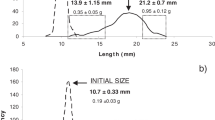Summary
Field metabolic rates (FMRs; CO2 production) and water influx rates of Varanus rosenbergi were measured seasonally by means of doubly-labelled water (3H2 18O). Metabolic rates and water influexes were highest in summer (0.18 ml CO2 g−1 h−1 and 17.9 ml H2O kg−1 day−1) and lowest in winter (0.04 ml CO2 g−1 h−1 and 6.5 ml H2O kg−1 day−1). FMRs and water fluxes were intermediate in spring. It is estimated that a 1-kg V. rosenbergi would need to consume 4.7 kg of prey each year to remain in energy balance and that the energy commitment to egg production requires a 40% increase in the food acquisition of a gravid female in late spring and early summer. It is calculated that water influxes in summer are totally provided from food but in other seasons, particularly winter, pulmocutaneous water exchange and/or drinking are significant avenues of water intake.
Similar content being viewed by others
References
Anderson RA, Karasov WH (1988) Energetics of the lizard Cnemidophorus tigris and life history consequences of food acquisition mode. Ecol Monogr 58: 79–110
Avery RA (1971) Estimates of food consumption by the lizard Lacerta vivipara Jaquin. J Anim Ecol 40: 351–365
Bartholomew GA, Tucker VA (1964) Size, body temperature, thermal conductance, oxygen consumption and heart rate in Australian varanid lizards. Physiol Zool 37: 341–354
Bennett AF (1973) Blood physiology and oxygen transport during activity in two lizards, Varanus gouldii and Sauromalus hispidus. Comp Biochem Physiol 46A: 673–690
Conway EJ (1962) Microdiffusion analysis and volumetric error. Crosby-Lockwood and Son, London
Dryden G, Green B, King D, Losos J (1990) Water and energy turnover in a small monitor lizard, Varanus acanthurus. Aust Wildl Res 17: 641–646
Green B (1972) Water losses of the sand goanna (Varanus gouldii) in its natural environments Ecology 53: 452–457
Green B, King D (1978) Home range and activity patterns of the sand goanna, Varanus gouldii (Reptilia: Varanidae). Aust J Wildl Res 5: 417–424
Green B, King D, Butler H, (1986) Water, sodium and energy turnover in free-living Perenties, Varanus giganteus. Aust Wildl Res 13: 589–595
Green B, King D, Braysher M, Saim A (1991) Thermoregulation, water turnover and energetics of free-living Komodo dragons, Varanus komodoensis. Comp Biochem Physiol 99A: 97–101
Horn HG, Visser GN (1989) Review of reproduction of monitor lizards, Varanus spp. in captivity. Int Zoo Yearb 28: 140–150
King D (1980) The thermal biology of free-living sand goannas (Varanus gouldii) in southern Australia. Copeia 1980: 755–767
King D, Green B (1979) Notes on diet and reproduction of the sand goanna, Varanus gouldii rosenbergi. Copeia 1979: 63–70
Kitchell JF, Windell JT (1972) Energy budget for the lizard Anolis carolinensis. Physiol Zool 45: 178–188
Lifson N, McClintock R (1966) Theory of use of the turnover rates of body water for measuring energy and material balance. J Theor Biol 12: 46–74
Messer M, Green B (1979) Milk carbohydrates of marsupials. II. Quantitative and qualitative changes in milk carbohydrates during lactation in the tammar wallaby (Macropus eugenii). Aust J Biol Sci 32: 519–531
Nagy KA (1980) CO2 production in animals: analysis of potential errors in the doubly labelled water method. Am J Physiol 238: R466–473
Nagy KA (1982a) Field studies of water relations. In: Gans C, Pough FH (eds) Biology of the Reptilia. Vol 12C Academic Press, London, pp 483–501
Nagy KA (1982b) Energy requirements of free-living iguanid lizards. In: Burghardt GM, Rand AS (eds) Iguanas of the World: their behaviour, ecology and conservation. Noyes Publications, Park Ridge, New Jersey, pp 49–59
Nagy KA, Costa DP (1980) Water flux in animals: analysis of potential errors in the tritiated water method. Am J Physiol 238: R454–465
Nagy KA, Peterson CC (1988) Scaling of water flux rate in animals. Univ Calif Publ Zool 120
Pianka ER (1982) Observations on the ecology of Varanus in the Great Victoria Desert. W Aust Nat 15: 37–44
Storr GM (1980) The monitor lizards (genus Varanus Merrem, 1820) of Western Australia. Rec W Aust Mus 8: 237–293
Vaughan BE, Boling EA (1961) Rapid assay procedures for tritiumlabelled water in body fluids. J Lab Clin Med 57: 159–164
Vernet R, Lemire M, Grenot C (1988) Field studies on activity and water balance of a desert monitor Varanus griseus (Reptilia, Varanidae). J Arid Environ 15: 81–90
Weavers BW (1983) Thermal biology of Varanus varius (Shaw), the Lace Monitor. Ph.D. Thesis, Australian National University, Canberra
Author information
Authors and Affiliations
Rights and permissions
About this article
Cite this article
Green, B., Dryden, G. & Dryden, K. Field energetics of a large carnivorous lizard, Varanus rosenbergi . Oecologia 88, 547–551 (1991). https://doi.org/10.1007/BF00317718
Received:
Accepted:
Issue Date:
DOI: https://doi.org/10.1007/BF00317718




